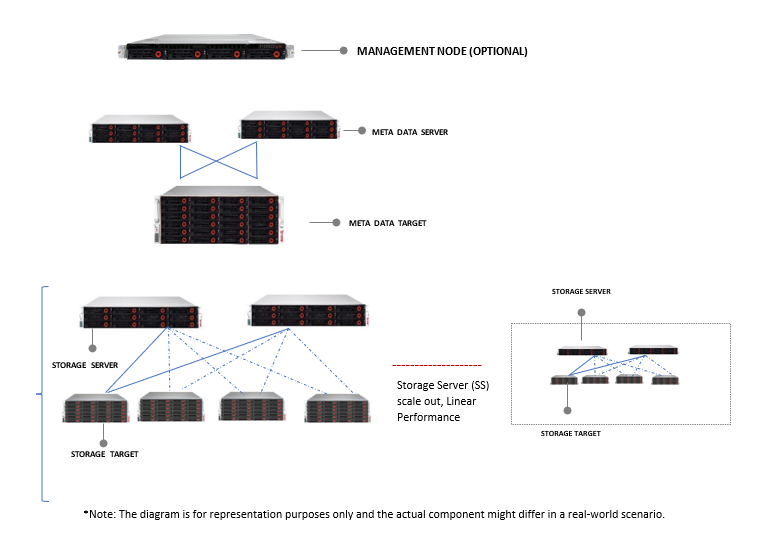ParallelStor is a high-performance PFS storage solution specially developed for massive enterprise requirements with high availability as one of its many highlights. It is a proven integrated solution with a simple and scalable infrastructure to keep abreast with the most demanding workloads. The solution boasts of some brilliant performance metrics such as high throughput, high bandwidth (EDR-100GB/s, HDR-200GB/s), and high density (in various configurations).
Download PdfWith the proliferation of new and emerging technologies such as artificial intelligence (AI), and 3D imaging the volume of data being handled in an organization is increasing exponentially. The need of the hour is a high-performance PFS storage solution like ParallelStor. The solution seamlessly spreads the collected data across multiple servers. Moreover, by simply increasing the number of disks and servers in the system, the file system's performance and capacity can be scaled easily to the desired level. The scaling can be seamlessly achieved from small clusters to enterprise-class systems supported by thousands of nodes.


Storage is as critical as incredible computing power. For example, even the fastest and leanest machine will not draw applause if the storage is not equally fast.
ParallelStor understands the conundrum and provides consistent concurrent, real-time access to your data. To prevent bottlenecks and facilitate continuous high-performance data spread across multiple servers and their backend storage. It also has an in-built technology to monitor workloads and automatically adjusts configurations for maximum performance.
Through its inherent design, ParallelStor separates file content and metadata. While storage servers take care of storing portions of the actual file content, the metadata server helps in the coordination of file placement and striping. The client can directly connect with storage servers and communicate with more than one server, leading to true parallel access to the file data.
From its very inception, ParallelStor has been optimized for a high data throughput with a concerted effort on flexible scaling. Technically, the solution encompasses multiple storage servers to deliver a highly scalable and flexible network file system that supports striped file content.
Apart from the deployment cost, one must also deliberate the operating costs of the solution once deployed. ParallelStor HDDs and SSDs adheres to strict performance, quality and interoperability requirements. The additional scrutiny considerable reduces the failure rate eventually bringing down the total cost of ownership.
ParallelStor delivers a high-availability (HA), shared disk solution for PFS storage. The solution introduces an additional level of data access protection without the requirement for data duplication. The protection ensures an enterprise ready PFS which instantly recovers from any unseen fault or failure, keeping the crucial application always running.
In an environment where complexity is rampant, simplicity is critical. Unlike the existing parallel file system in the market, ParallelStor does not need multiple platforms and models to scale. The storage solution is easy to deploy and support.
ParallelStor is also capable of distributing the metadata across multiple servers to minimize the metadata access latency. By doing so, each of the metadata servers stores only a section of the global file system.



Tyrone Bespoke PFS Storage Solution for HPC or ParallelStor is a wholly supported storage solution with high throughput. The solution includes a management node -that is optional – a pair of metadata servers (MDS), a metadata target (MDT), a pair of storage servers, and related storage arrays. The pair of MDS is connected to MDT by high-performance links. The pair of storage servers host the storage target for Parallel File System.

ParallelStor management service is set up on both metadata servers. The management store is initialized directly in the management directory on the metadata target.

Within ParallelStor, every metadata service takes care of only one metadata target. For example, if there are twelve MDTs, there need to be twelve instances of metadata services. The metadata targets are formatted to perform exceptionally with small file operations. Moreover, ParallelStor also captures information directly on the inodes of the file system for delivering optimal performance.

In a high-capacity, ParallelStor solution the data storage is achieved across four storage targets or arrays. On each storage array, linear disk groups of variable drives are created. For every disk group, a single volume utilizing all the space is also created.

The ParallelStor client module is loaded on all the hosts that need access to the file system. Once the module is loaded and the client service is started, the service mounts the file system predefined in the module. With the approach, the client service starts similarly to other Linux services via the service start-up script and facilitates the automatic recompilation of ParallelStor client module once the system updates.